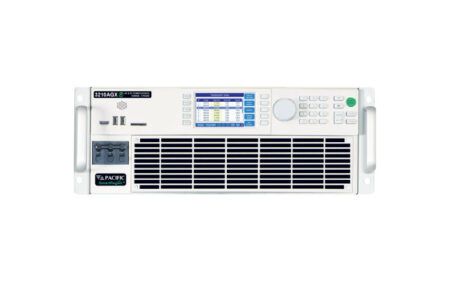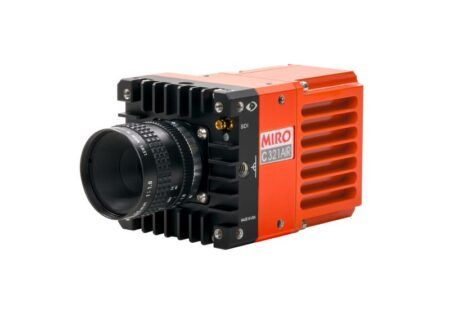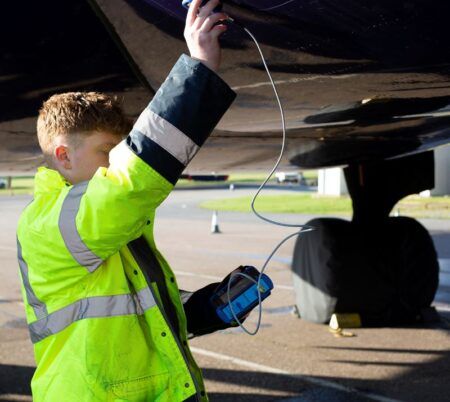Hypersonic FTI requirements
There has been a significant increase in hypersonic vehicle development in recent years, for both passenger aircraft and hypersonic weapons. Their unique designs and the extreme Mach 5 speeds at which they operate present a number of challenges for FTI.
Given the design complexities, new materials, and great expense in developing hypersonic vehicles, it becomes even more critical to get the flight test stage right the first time. Thus, FTI solutions must put more emphasis on reliability due to environmental conditions, possible loss of test articles, and the extra expense of repeating flight test points due to poor data collection.
For hypersonic vehicle FTI, getting DAUs closer to sensors is a good strategy as it reduces overall system wiring. Flexibility of DAU architecture can be highly beneficial here, with a mix of DAUs in different sizes and form factors that use the same, or compatible technology, providing specific benefits in different available locations.
For example, a larger DAU could provide high-speed avionics bus data acquisition in one location, while smaller DAUs are located in tight spaces to collect smaller data quantities from remote locations.
Curtiss-Wright has built up an extensive knowledge base about deploying FTI solutions in harsh environments, for applications such as space and hypersonic vehicles. These solutions deliver proven reliability and are available with an exportable encryption solution that provides a PCM encoder interface, an advanced range telemetry (ARTM) transmitter interface, and an optional cryptographic key management software package.
Curtiss-Wright’s range of DAUs offer the flexibility to better fit into a vehicle’s available space, such as the MDW-2020 that can exploit a large existing collection of Curtiss-Wright MnACQ modules, or the Axon that can use remote mountable modules to virtually extend the DAU into extremely tight spaces up to 10m(33ft) from a chassis
For more information please visit the Curtiss-Wright website.

Smart avionics testing
A wide acceptance of the AFDX/ARINC664P7 networking has seen it used on aircraft like the Airbus A380/A350/A400M, Boeing 787, Sukhoi SSJ 100, COMAC C919 and some helicopters including the AgustaWestland AW101/AW189/AW149 and new AW249. The success of this network for integrated avionics has seen its take up several new projects, further embracing the technology.
This brings new challenges for in service support and avionics developers, hence testing and data loading becomes a very important subject. In order to provide portable solutions with advanced test and loading functions for AFDX/ARINC664P7 networks, AIM released its second generation of USB based smart AFDX/ARINC664P7 test and analysis devices.
The device, known as a Smart Cable has the focus to offer an extremely small form factor which is portable and flexible. Optimized for low power consumption, the device requires only a single USB 2.0 Type A slot of a host computer to operate. Two RJ-45 connectors provide the link to the AFDX/ARINC664P7 redundant network and the speed is programmable at 10 or 100Mbit/s for the physical link.
Users can capture traffic with detection of physical, frame format, VL settings and redundancy violations including high-resolution time stamping of incoming frames. Tapping into a connection for capturing purposes with extremely low impact on latency is possible, as is gathering detailed statistics about received traffic.
Simulation of high precision, custom frame sequences with a wide range of error injection possibilities alongside simulation of multiple End-Systems via VLs and Com/SAP ports which support automatic sampling for sampling ports, traffic shaping, fairness scheduling on Sub-VLs and redundancy management. Detection of traffic shaping and redundancy violations induced by other End-Systems is possible.
The Smart Cable device has other useful features including IRIG-B based clocks synchronization to external clock masters, Trigger I/O and General Purpose I/O.
Users can easily program the device for their specific requirements with the Application Programmer’s Interface for custom applications in C or C++ or even using the Python library for writing Python applications.
Users are offered a large set of features making the device an essential companion for all AFDX/ARINC664P7 test, simulation, monitoring and data- loading applications.
For more information please visit the AIM website
Innovative acoustic panels improve wind tunnel performance
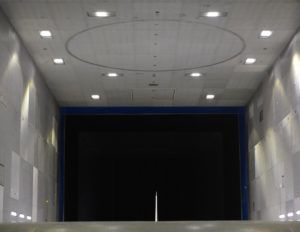
Jacobs has developed and implemented a new innovative solution featuring diffusion bonded mesh panels for the acoustic upgrade of wind tunnels for government and commercial aerospace and automotive clients. Implementation of this new solution revolutionized a 50-year-old aerospace facility, making it technically competitive with some of the best acoustic wind tunnels in the world.
Bonded mesh acoustic panels were also key to the successful revitalization of a 40-year-old automotive testing facility, enabling the facility to keep pace with current testing demands. The successful acoustic upgrade of a US government facility, touted as the most utilized low speed propulsion acoustic facility in the world, was also accomplished by implementing Jacobs’ innovative solution.
With each of these projects, the usefulness and capabilities of existing wind tunnels was increased to allow the facilities to meet more demanding current and future test requirements.
For each of the acoustic upgrades, Jacobs demolished the existing test section walls and ceiling to install a new test section designed and constructed with an innovative surface treatment. The basic concept involved developing a robust solution to combine a ultra-fine mesh screen with perforated panels using a high-strength diffusion bonding process. This allowed high speed air to pass over the walls and ceiling without generating noise.
Acoustic energy created by or reflected off of the test article passed through the test section boundary and was absorbed by acoustic absorbing materials behind the panels. Aerodynamically smooth and acoustically transparent, the solutions also featured a new support frame for the acoustic panels, new acoustic doors with a mesh-bonded panel arrangement, and new modular windows that could be replaced with removable acoustic panels during tests.
The acoustic upgrades significantly increased testing capability within the wind tunnels, resulting in a >15 dB(A) decrease in background noise levels across the wind speed range. The upgrades enable wind tunnel test engineers to measure and minimize wind noise created by their test articles (e.g., ground vehicles, aircraft engine or aircraft components) without the interference from background noise generated by the wind tunnel itself.
For more information please visit the Jacobs website
The demand for versatility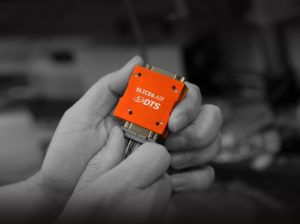
As many programs shift to what are being called ‘attritable’ platforms, the focus is on designs that are lower-cost, multi-use and require minimal maintenance. There is also a corresponding demand for short development cycles, which has led to a greater need for more versatile data acquisition units (DAU) to test at every stage.
The SLICE6 AIR, a miniature DAU created by California-based Diversified Technical Systems (DTS), is proving that one data acquisition unit can deliver what’s needed in both the lab and in flight.
“A good analogy for the SLICE6 AIR is the smart phone. Prior to smart phones we would use a computer and phone and television to do all those tasks a smart phone can do,” explains Huy Nguyen, DTS aerospace and defense sales manager. “With SLICE6 AIR, we’ve combined what was once individual components like analog signal conditioning, Ethernet network switch, recorder and encoder into an extremely compact all-in-one device.”
The unique packaging enables measurement capabilities in areas and locations never before possible. “Faster turnaround for development demands quick DAU installation. With this plug and play unit it’s easy to add measurement capabilities even on prewired test articles and in space-constrained locations,” continues Huy.
With all the SLICE6 AIR components bundled into a tiny 50-gram package it can be added virtually anywhere including on a rotor in the lab for validation testing, or for flight tests on UAVs such as Drones, without affecting the test dynamics.
SLICE6 AIR features universal analog sensor support, signal conditioning, flash memory, real-time streaming in IRIG-106 (Chapter 10 or TmNS) and can easily be integrated with other flight test systems on the market. Since the unit is self-contained, it eliminates long cable runs reducing set up time and cost. DTS software makes it easy to correlate data at every phase of testing.
The AIR version is based on the original SLICE6 technology DTS developed for the US Army WIAMan blast manikin.
“SLICE6 AIR is so small it offers a level of flexibility many customers didn’t realize was possible at this price point,” concludes Huy
For more information please visit the DTS website.
Sensors designed for extreme environments
Meggitt HTP manufactures accelerometers designed for use in extreme high temperature and radiation environments. The piezoelectric material selection, design parameters and processes are important in determining the best solution for the intended environment.
The development of such accelerometer starts with a number of considerations about the application, the desired features and thus the conditions the unit will be required to operate in.
The piezoelectric crystal elements could be inherently piezoelectric, either a natural single crystal or a grown single crystal, or a ferroelectric ceramic where high voltage aligns polar regions within a ceramic material resulting in the piezoelectric effect.
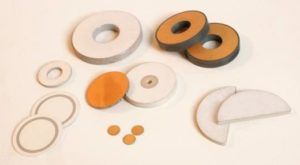 Each material has unique features and advantages which define the design. Piezoelectric material is selected for its behavior and inner characteristics. With this, the design is predictable and repeatable, in the required temperature range and the intended use.
Each material has unique features and advantages which define the design. Piezoelectric material is selected for its behavior and inner characteristics. With this, the design is predictable and repeatable, in the required temperature range and the intended use.
Design trade-offs have to be considered among maximum temperature (Curie point), bandwidth, sensitivity and source impedance. Expected temperature change rates shall be considered too while choosing material: pyroelectric effect is definitely undesired in your measurement when performing integration from acceleration signals.
When operating at temperatures above +500o F (+260o C), special attention must be given to sensor design and any other element materials selected as temperature will affect them. Everything must be considered: from sealing methods and construction to mechanical parts and metal selection.
Temperature changes can cause high stresses from the materials mismatched thermal expansion coefficients. Again, at high temperatures, material strength decreases, insulating materials deteriorate and some crystal materials inner characteristics can change.
Connector’s reliability can degrade at temperatures over 900F and consideration must be given to how many times a connector and cable will be mated as pin retention can be reduced. For this reason, most extreme temperature sensors will have integral cables that allow the connector to be located in a cooler location. The integral mineral cable itself is mechanically isolated from the crystal stack and the unit base, this to prevent strains due to mechanical or temperature solicitations.
Regarding the use in nuclear environment, Meggitt defines the total amount of radiation dose that the accelerometer can withstand without affecting measurement. These are an integrated gamma flux of up to 6.2×1010 rad and an integrated neutron flux up to 3.7×1018 N/cm2 are the typical values.
For more information please visit the Meggitt High Temperature Products website
Hydrogen under control
The aviation sector emits more than 900 million tons of carbon dioxide into the atmosphere every year. Reducing carbon dioxide emissions within the sector is therefore crucial to achieving lower global carbon emission targets, in our collective effort to support climate change objectives.
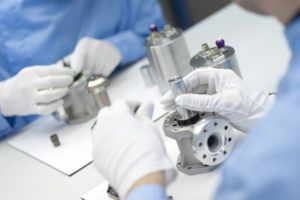 Green hydrogen is the ideal energy storage medium when it comes to avoiding carbon dioxide emissions. Hydrogen has the highest gravimetric energy balance of the fuels and is therefore ideally suited for aviation. Modified piston engines or turbines as well as fuel cells and electric drives can be used as propulsion systems. All of these options require one or more H2 tanks.
Green hydrogen is the ideal energy storage medium when it comes to avoiding carbon dioxide emissions. Hydrogen has the highest gravimetric energy balance of the fuels and is therefore ideally suited for aviation. Modified piston engines or turbines as well as fuel cells and electric drives can be used as propulsion systems. All of these options require one or more H2 tanks.
They are designed either as pressure tanks for up to 800bar or as liquid hydrogen tanks for around -253°C, at about 10bar. The control of the medium between tank, inlet and consuming device is achieved via a fuel system consisting of valves, safety assemblies, piping and various measuring instruments.
In this context the individual valve types are of particular importance. They must function reliably in extreme temperatures (cryogenics) or pressure ranges (high pressure tanks). Standards for these valves are partly still absent in aviation and will only develop gradually in the future.
Test-Fuchs has proved to be a reliable and competent partner in terms of development, testing and production of valve technology for many years. Technological innovations are analyzed together with customers in advance, concepts are developed, and prototypes are manufactured and tested.
A working example of this type of technology are the Test-Fuchs cryogenic valves, which operate reliably in extreme temperature ranges of down to -253°C using hydrogen, helium or oxygen. These valves are used in the Ariane 5 and Ariane 6 space program. In addition, Test-Fuchs also produces hydrogen valves for the automotive development and pre-production field.
As one of the largest test equipment manufacturers in the aviation industry Test-Fuchs offers perfectly adapted test environments and test benches for the required systems. In order to get the appropriate aviation certification, application-oriented test environments are needed, and Test-Fuchs offers these as well.
For more information please visit the Test-Fuchs website
Telemetry solutions
Processing telemetry data efficiently and quickly has turned into a real issue for modern Telemetry Range due to ever complex test configurations.
In recent decades, telemetry data formats have evolved on board and in ground installations with the development of new data encapsulation formats (CH10, CH7, TMoIP, IENA, AFDX, proprietary hardware format) and evolution of transmission protocols to get closer to standard network formats (TCP/IP, UDP/IP).
The emergence of distributed architecture connected through Ethernet network has provided Telemetry Centers with outstanding performance and scalability at less cost.
To meet these changes and not compromise their general architecture, Telemetry Centers carry out their refurbishment by successive iterations to lower costs and secure the integration of new hardware and software bricks. One major consequence is the appearance of heterogeneous telemetry PCM inputs and data formats: CH10 packed, unpacked, PCM Data + Clock, raw PCM over IP, TMoIP, Hardware proprietary format, CH7.
In addition, Telemetry Ranges with several remote sites have to process the Best Source Selection (or Best Source Combination) to get in real time the best uninterrupted telemetry stream at all position of the target to track. All telemetry streams are concentrated to the Telemetry Data Center to be processed whatever data format proposed by the hardware. In this context, it is as important for program managers to have efficient and reliable data processing solutions as having the choice of data transmission / reception equipment.
Nexeya has been working for many years with global flight test centers and is continuously improving its data processing technologies to overcome current constraints: heterogeneous hardware, heterogeneous input data, increased data processing (data harshness, latency, encryption and noise issues) and distribution to several sites.
Nexeya offers turnkey solutions to satisfy the most demanding requirements: efficient best source selection/combination to deliver in real-time the best source from up to 16 PCM data streams, full capabilities to process heterogeneous inputs (physical or Ethernet) and formats (CH4, CH7, CH10, TMoIP) and advanced post processing functionalities based on Web Server technology for optimal and immediate access to test data.
For more information please visit the Nexaya website
High accuracy in extreme cold
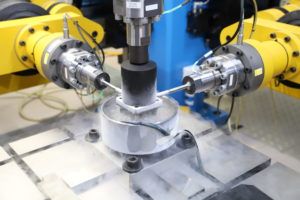
Space offers the most extreme conditions in every sense. Satellites and spacecraft need to withstand temperatures that are as low as -270˚C (-454˚F).
To ensure that critical instruments do not fail, cryogenic tests prior to launch are vital. Testing equipment plays a decisive role in these simulations and must meet the strictest requirements in terms of accuracy and reliability.
Kistler, a provider of piezoelectric sensor solutions, tests its cryogenic measuring devices in liquid nitrogen at -196˚C (-320˚F). Piezoelectric sensors are chosen when it comes to measuring dynamic forces and moments with high accuracy. At the heart of each sensor is a thin yet durable quartz crystal that releases an electrical charge when force is applied. In their cryogenic test series, the experts at Kistler analyzed any potential change in test results at the point when the components including the quartz itself contract due to extremely low temperatures. They examined the linearity of the electrical charge, the hysteresis and the sensitivity of the sensor.
“We knew our sensors can withstand very harsh conditions,” Martin Betschart, product manager at Kistler, explains. “But we were happy to confirm that the low temperatures do not affect the performance of the sensors. Despite these extreme temperatures they still meet the specifications.”
Each sensor is hermetically sealed to ensure reliable operation and accuracy, no matter how cold it gets.
For more information please visit the Kistler Group website



